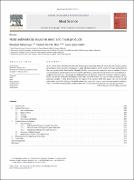| dc.description.abstract | In the recent years, Muslims have become increasingly concerned about the meat they eat. Proper product
description is very crucial for consumers to make informed choices and to ensure fair trade, particularly in
the ever growing halal food market. Globally, Muslim consumers are concerned about a number of issues
concerning meat and meat products such as pork substitution, undeclared blood plasma, use of prohibited ingredients,
pork intestine casings and non-halal methods of slaughter. Analytical techniques which are appropriate
and specific have been developed to deal with particular issues. The most suitable technique for any
particular sample is often determined by the nature of the sample itself. This paper sets out to identify
what makes meat halal, highlight the halal authenticity issues that occur in meat and meat products and provide
an overview of the possible analytical methods for halal authentication of meat and meat products. | en_US |

